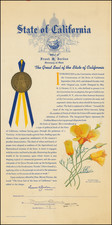The Unfortunate Ass, a satirical print published on March 11, 1784, by W. Humphrey of 227 Strand, captures the political tension between King George III and Charles James Fox, set against the backdrop of the burdensome taxation on the populace. This etching illustrates the divergent political ideologies of the era, with the monarch and Fox symbolizing the struggle for power and control over fiscal policies.
In this print, the central figure is an ass, labeled "The People," heavily laden with sacks marked "Taxes" and "Taxes 1784." The ass stands between George III and Fox, each pulling a rope attached to its nose, symbolizing their tug-of-war over public support and tax revenues. The king, adorned with a crown and wielding a sword inscribed "Prerogative," attempts to drag the ass toward a signpost reading "Road to Absolute Monarchy." This imagery highlights the monarch's inclination towards reinforcing royal prerogative and centralizing power.
Conversely, Fox, positioned on the left, is depicted pulling the ass toward a signpost labeled "Road to Republicanism." His statement, "I humbly Insist upon the management or else will not grant any Supplys," underscores his push for parliamentary authority and fiscal oversight, representing the Whig opposition to royal dominance. This scene encapsulates the ideological battle between absolutism and emerging republican sentiments during a period of significant political upheaval.
The print also includes a distant signpost pointing "To Aristocracy," indicating a third, less prominent path, perhaps alluding to the aristocratic influence in politics, yet overshadowed by the more dominant struggle between the crown and the Whigs. This artwork, rich in allegory and political commentary, provides a visual narrative of the tensions and debates surrounding governance, taxation, and representation in late 18th-century Britain.
M. Dorothy George, in her Catalogue of Political and Personal Satires in the British Museum (1938), provides an extensive analysis of this print, noting its relevance to contemporary political discourses and the specific references to Pitt and prerogative, as well as Fox and republicanism. The etching serves not only as a piece of artistic satire but also as a historical document reflecting the complexities of British political life during the reign of George III.










![[ John Law / Mississippi Bubble ] De laggende Law, de treurende actionist met de smekende Mercurius (Law laughing, the shareholders mourning, and Mercury begging.)](https://storage.googleapis.com/raremaps/img/small/104296.jpg)


![[ The Dying Bubble-Lord in the Lap of Madame Compagnie ] De stervende Bubbel-Heer in den schoot van Madame Compagne](https://storage.googleapis.com/raremaps/img/small/104094.jpg)
![March on the Democratic Convention - Bastille Day Marijuana Parade Saturday, July 14th, 1984. [and] White House Smoke - In](https://storage.googleapis.com/raremaps/img/small/102586.jpg)